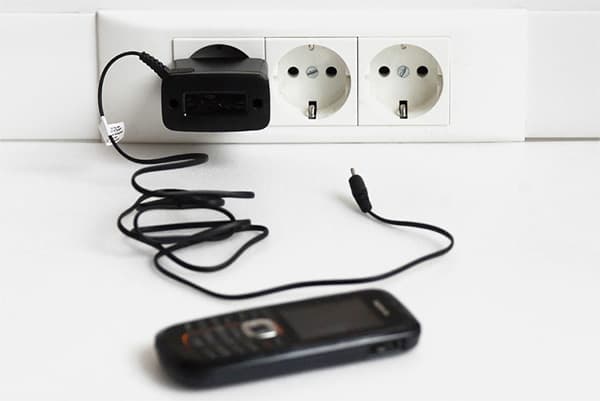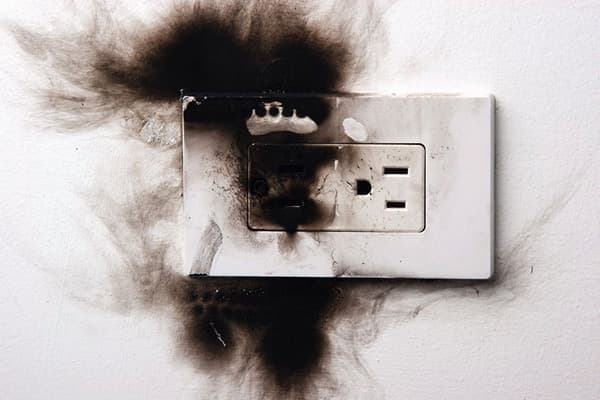Is it possible to leave charging in the socket without a phone: three myths and one truth
Of course, you can leave a charge in the outlet. This was verified by personal experience of millions of people. But there are so many myths created around this practice that it is very difficult to distinguish the right advice from the wrong one. Let's understand the issue and find out the opinion of experts - after all, there is a risk in any case, albeit in most cases not very large.
Power consumption
The charger really consumes electricity all the time, even without a phone. But do not try to reduce your electricity bills by disabling charging. In passive mode, the device consumes a tiny amount of energy, for a month it wraps up a few cents. If you do not turn off the charger from the outlet for a year, the expense will be 1/3 kilowatt. With such savings, you can’t fix the family budget. But if you basically do not want to pay an overrun, even such a small one, pull the charger out of the socket. This is not a question of money, but of desire.
Reduced Life
Another popular myth claims that the “lifespan” of the charger is limited. The longer the charge is plugged in, the faster it will go bad.
There is some truth in this. The life of the device is an average of 50,000 hours. This is about 2000 days, that is, almost 6 years. Therefore, the power supply can be connected to the network for as long as 6 years, and it will not hurt him.
Let's say you will constantly turn off the device. Then the service life will increase by several years. But does that make sense? For 5 years, the power supply will probably have to be replaced - it will be scratched, the connectors will loosen, it may even break. Many people even change smartphones in 3-4 years, because the models are becoming obsolete.
But if you want the charger to work for 10-15 years, and are sure that it will not break for other reasons, be sure to unplug it from the network.
Fire hazard
There are sockets with USB ports. In appearance, this is a regular outlet with the usual round connectors, below which there are rectangular ports - the same as on chargers. And the "filling" at the outlet is the same as that of the charger. Not only wires, but also circuits are hidden under the lid. So, this is the same power supply, only stationary - mounted directly into the wall. And it is connected to the network - constantly. Nothing lights up. So you can not be afraid of a fire - the power supply will not break out and will not set fire to the house.
But be careful if there are common risk factors in the house:
- old or faulty wiring;
- lack of automatic protection against short circuit and overloads.
In this case, anything can happen. But the problem is not charging - a short circuit can occur on any part of the circuit. To reduce the risk, do not leave the equipment connected to the network unattended - even a TV and a refrigerator. And better - replace the wiring and put a reliable machine and do not worry about anything.
Another good reason to disconnect the charger is a thunderstorm. But again, the problem is not with the power supply. From the outlets you need to turn off all equipment, these are standard fire safety rules.
And of course, you can not leave a faulty power supply in the outlet. It does not need to be used at all - so you can lose your phone.
Children in the house
This is the only convincing reason to turn off the charge and put it away. You can put a plug on a regular outlet, but you can’t do this with a charger.
The power supply is dangerous even in a passive state. The baby is unlikely to stick a finger in the port - the connector is narrow with a listen. But the child may well use some kind of metal object - a knitting needle, a nail, a narrow handle of a spoon. In addition, the cord is easy to cut or bite, even strong insulation is not designed for children's games.
The charger has an output current of up to 2 A, and a voltage of up to 5 volts. Such an injury is very painful, so do not risk it. Hide chargers in places where kids cannot climb.
If there is a dog or a cat in the house, the power supply should also be removed away. Animals love to chew on wires. A short circuit may not happen, but you will definitely lose your charger.
But let's look at the problem from the other side. What happens if we turn off the device as soon as the phone is charged? Just spend a couple of seconds of your life. If you can turn off charging, do it. It’s safer.




Just the same, the statement that a voltage of 5 volts can cause an electric shock to a person is complete nonsense. This will be confirmed by anyone with an electrical education.
But the fact that a significant part of the charges on the market are rootless Chinese crafts, with simplified circuits and minimal protection (or no protection at all) and are simply unsafe to operate, has a place to be. Therefore, it is still worth removing the charge from the outlet if it is not used.
It’s safer to turn it off all the same. It will be calmer.
Addition to the complete nonsense.
Answer please:
what a deadly strain
for a person on the lower surface of the tongue,
closer to the base?
THAT!
Actually, the current occurs in the presence of voltage and depends on the magnitude of the voltage!
5 Volt is safe for humans, but it can also be energized to 220 V if a phase wire breaks out and the person has contact with the Earth (for example, stands on a damp floor that has contact with the Earth or zero)
All voltages above 36 volts are considered life-threatening, PTB,
Boys, do not quarrel. Elementary safety rules for children should be instilled in childhood.
Catherine! Electricity is measured in kW * h, and in kW - measured power!
I've always pulled out charging from the outlet after charging the battery in the phone or other gadgets.
If there is no connected consumer, what kind of fire hazard can be discussed, any student who taught physics should know that there heats up and simply does not catch fire
I dick scored on the charger. I haven’t pulled out for many years. I charge, then a tablet, then a smartphone from one non-native charger😁
Another nonsense from the madhouse! Author, move away from the keyboard and do not litter the Internet and the brains of normal people with your own fabrications !!
A friend’s house burned down due to the charge left in the socket.
08.08.13 A thunderstorm has begun. The woman said that I left the outlet. I damaged, but left on the opposite side. And then a miracle happened. First, a flame came out - more than a meter long, the socket burned out, then a deafening thunder. And you say ...
It flew away unknown!
In fact, if you constantly keep the charger in the network, the PWM chip and key transistors can degrade. I personally saw it. There is a charger, at idle it seems to give out its 5 volts, and under load the voltage sags to 3 volts. I look, and where is the PWM chip, the textolite is characteristically darkened, which indicates its chronic overheating.
But this is for the most part the problem of cheap memory. Good branded devices are usually not that different.
5 volts and 2 Amperes can be shoved into a baby’s mouth at least - he almost doesn’t feel anything, so there’s no need to say that it’s dangerous.
author do not write more to listen to you and flat batteries of 4.5 volts are deadly gygygy
“Do not leave the equipment connected to the network unattended - even a TV and a refrigerator
"Ok telly, but REFRIGERATOR !!!! the author as he imagines it
??????
Laughed from the article and from the comments. Comrades! Site name purityguide.techinfus.com/en/:tips for beginner housewives. And all men spit saliva proving something!
Adults, and drive such nonsense.
We found the time to charge.
It’s necessary to do business and family.
Kick
When leaving, turn off the refrigerator from the outlet !! ...
Disconnect everything to everyone! Do not take too much into your mouth! Do not let children, cats and dogs out! Amen!
It is possible to leave, but only the old type assembled on ordinary transformers, modern charges are structurally flammable, since on a very small board there are elements with a mains voltage and with a low output, some moisture, dust, an explosion is generated, in addition, the mains voltage directly comes through the diode bridge immediately to the electrolytic condenser, after rectification 308 volts are formed on it, the manufacturer saves by putting them at 400 volts, anado at least 600, I personally exploded such a charge, it is well wired in cabbage soup tke worked.
Charging is designed for 220 and in case of exceeding the input voltage, air gaps will be broken and all input voltage will be exhausted. It's just that dear ones need a lightning strike and kilovolts. And the cheap may have enough phase imbalance. So in the city and normal exercise - not scary. And in the country - chernz surge protector on or off
Usb charging with schpmots on textolite? Where did they get that?
So that you don’t break your spears here: it’s dangerous not the voltage itself, the current that will flow through your body. So this is a life-threatening value of 0.1 A. Another question is how it passes through you. If you have skin, like a hippo is thick, you can also try 380V. I personally knew such a unique one. But try to take a little email. From the toy, connect the battery with wires to it so that it works. I would not advise taking the contacts of the battery or motor with each hand for each contact. The current through the arms and body is more than enough. And about the exercises: well, if you want, risk your housing or health - this is your right. And self-confident, please experiment further. Maybe the obituary will read about you later.
My charging from the laptop burned out with a slight explosion during a power surge. The benefit of the house was ...
My hut burned out from the charger
In my eyes, in the name of my house, the charger caught fire.
It is intelligible! Thanks!
and I have already turned on charging for about 10 years, I must probably turn it off, I never thought about it
Turn off necessarily. Who knows the typical charger circuit, he will confirm that after the rectifier there is a 250-volt filter capacitor, and should at 400 volts, this is the most unreliable element of the circuit. So it explodes and burns out most often with all the ensuing consequences.
Electronic engineer with 45 years of experience.
IMHO, Alexander from 09/29/2024 is closest to the truth. Only the capacitor is placed at 300 volts. Yes, the effective voltage in the network is 220 volts, but the amplitude = 300 volts. And the capacitor is not filtering, but lowering. It replaces the transformer in old circuits and works as capacitive resistance. We need to lower the network voltage of 220 volts AC to a lower one, relatively speaking, to 5 volts in simple circuits and rectify it with a bridge of 4 diodes. With a filtering electrolytic capacitor at the output, which smooths out voltage ripples. But what happens during power failures or when charging is manually turned on? AC voltage varies in a sinusoid from 0 to 300 volts. If, when charging is turned on, you get to the peak of a positive half-wave or the voltage in the network “jumps” for fractions of a millisecond and the positive half-wave goes again, then the voltage will reach 600 volts in amplitude. Capacitor may fly out. But if it doesn’t even fly out right away, the electrolytic capacitor at the output of the circuit can fly out. Which, and so, as a rule, is designed for 5 or 6.3 Volts (the Chinese save), and without load (smartphone, tablet, etc.) it works with overload. In addition, in more expensive circuits, a transistor circuit (multivibrator) and a low voltage transformer at the circuit output are used. This is done for electrical isolation of the network and load. Transistors, as a rule, MJE13001 (MJE13003 PCR606J PCR406J) also really do not like a voltage increase of 2 times. In this case, your smartphone will not burn. But the apartment can))). Hence the conclusion: do not keep charging turned on without load and turn on and off through the switch. And you say, the main threat is a thunderstorm))).Even if lightning in a big city gets into the electric network (which is very unlikely), then the first thing you will burn a TV, relatively speaking, for 40 thousand rubles., And charging for 100 rubles. can be neglected. Or do you, at the first sign of a thunderstorm, quit your job, rush home and turn off the TV from standby?
Electronic engineer with 55 years of experience. 11/01/2019